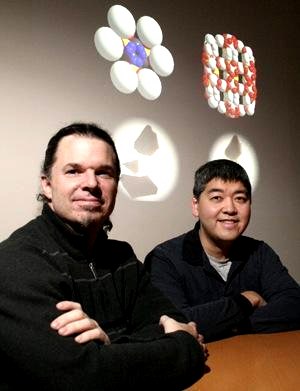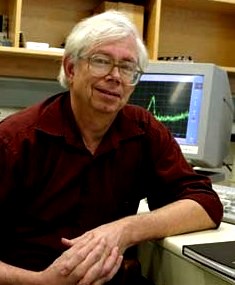New materials that act like nanoscopic gas cylinders complete with temperature-controlled gas taps have been developed by researchers in Canada. The materials hold the promise of climate control based on providing a safe means to store hydrogen gas produced in a sustainable way for electricity-generating fuel cell powered vehicles and also for trapping carbon dioxide and so reducing greenhouse gas emissions.
George Shimizu, David Cramb, and graduate student Brett Chandler of the University of Calgary and their colleagues Gary Enright, Konstantin Udachin, Shane Pawsey, and John Ripmeester of the Steacie Institute for Molecular Sciences at the National Research Council of Canada say the new technology represents a novel method of gas storage that could yield benefits for capturing, storing and transporting gases more safely and efficiently.

David Cramb (left) and George Shimizu building nanoscopic gas cylinders (Credit: Ken Bendiktsen)
This is a proof of concept that represents an entirely new way of storing gas, not just improving on a method that already exists,” said U of C chemistry professor George Shimizu. “We have come up with a material that mechanically traps gas at high densities without having to use high pressures, which require special storage tanks and generate safety concerns.
Writing in the journal Nature Materials, Shimizu and colleagues describe the invention of nanoscopic gas cylinders. The material is based on the orderly crystal structure of porous barium organotrisulphonate, which the researchers explain has a unique metal-organic framework (MOF) structure with open channels that hold gas molecules and can be closed off quickly to form air-tight cylinders when heated slightly to expel water from the structure. The rehydration of the material by simply adding water opens the valves again allowing the trapped gas to be released.

Gases on tap (Credit: David Bradley)
The process is highly controllable and because we’re not breaking any strong chemical bonds, the material is completely recyclable and can be used indefinitely, Shimizu explains.

John Ripmeester
This new material overcomes several conflicting properties of MOFs that have plagued research into such porous materials until now with the result that the new material is robust (so will not disintegrate), highly porous (so can trap a large volume of gas), crystalline (chemically simpler to handle) and dynamics (makes it an open and shut case). This reconciliation is enabled by the cooperative use of weaker, less-directional interactions and results in a new functional material with properties intermediate to organic and inorganic solids, the researchers add.
The next step is to extend the nanocylinder concept to other lighter materials based on sodium and lithium, which could trap smaller gases, such as hydrogen and helium, more efficiently. These materials could help push forward the development of hydrogen fuel cells and the creation of filters to catch and store gases like carbon dioxide or hydrogen sulphide from industrial operations,” Cramb adds.
Further reading
Nature Mater., 2008, in press
http://dx.doi.org/10.1038/nmat2101
Dr. George K.H. Shimizu’s homepage
http://www.ucalgary.ca/chem/pages/shimizu
John Ripmeester’s homepage
http://steacie.nrc-cnrc.gc.ca/personal/ripmeester/rip_index_e.html